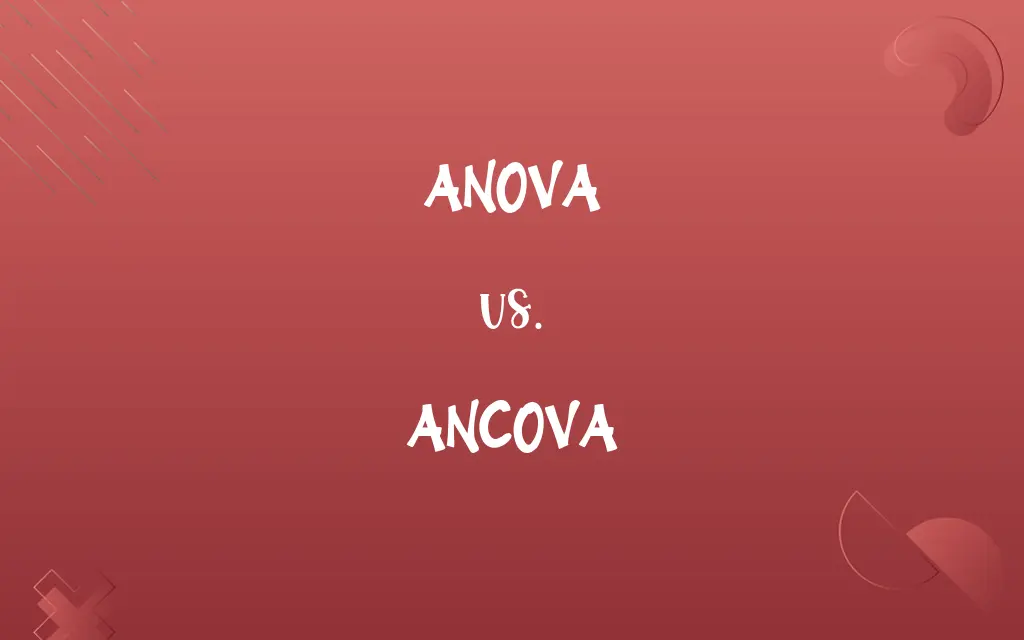ANOVA vs. ANCOVA: Know the Difference

By Shumaila Saeed || Published on January 19, 2024
ANOVA (Analysis of Variance) tests differences between means of independent groups, while ANCOVA (Analysis of Covariance) adjusts these means for covariates.

Key Differences
ANOVA is a statistical method used to compare the means of three or more independent groups to see if they differ significantly. It helps in understanding if at least one group mean is different. ANCOVA, on the other hand, is a blend of ANOVA and regression. It evaluates mean differences between groups while controlling for the effects of one or more covariates, which are continuous variables that could affect the dependent variable.
Shumaila Saeed
Jan 19, 2024
The primary function of ANOVA is to test for significant differences among group means without considering other variables. It's useful when the goal is to determine whether there's a significant difference due to a specific factor. In contrast, ANCOVA adjusts the means of the dependent variable for differences in covariates, effectively isolating the effect of the independent variable of interest.
Shumaila Saeed
Jan 19, 2024
ANOVA works on the assumption that covariates, if any, do not affect the outcome variable. It is less complex and used when the focus is solely on group differences. ANCOVA, however, assumes a linear relationship between the covariate and the dependent variable, and it's more complex as it adjusts the dependent variable for covariates before comparing group means.
Shumaila Saeed
Jan 19, 2024
When using ANOVA, you can't control for external variables that might influence the outcome. It's purely about group differences. ANCOVA is more sophisticated in this respect, allowing for control over extraneous variables, which makes it a more powerful and precise tool when these variables are known to affect the outcome.
Shumaila Saeed
Jan 19, 2024
In research design, ANOVA is appropriate when the research doesn't involve covariates or when these covariates are not of primary concern. ANCOVA is suitable when the research aims to understand group differences while accounting for potential confounding variables that might influence the dependent variable.
Shumaila Saeed
Jan 19, 2024
ADVERTISEMENT
Comparison Chart
Main Purpose
Compare means of independent groups
Compare means of groups adjusted for covariates
Shumaila Saeed
Jan 19, 2024
Control for Covariates
No control for covariates
Controls for one or more covariates
Shumaila Saeed
Jan 19, 2024
Assumptions
Assumes no external variable effects
Assumes linear relationship between covariate and dependent variable
Shumaila Saeed
Jan 19, 2024
Suitability
Used when covariates are not a concern
Used when controlling for external variables is crucial
Shumaila Saeed
Jan 19, 2024
ADVERTISEMENT
ANOVA and ANCOVA Definitions
ANOVA
A tool for comparing mean differences across several independent groups.
ANOVA showed that employee productivity differed by department.
Shumaila Saeed
Jan 05, 2024
ANCOVA
A blend of ANOVA and regression for adjusted mean comparisons.
Using ANCOVA, we analyzed the impact of teaching methods on grades, adjusting for students' attendance.
Shumaila Saeed
Jan 05, 2024
ANOVA
Analysis technique for assessing variance among group means.
Using ANOVA, we determined whether diet types affected weight loss.
Shumaila Saeed
Jan 05, 2024
ANCOVA
Tool for assessing group differences while controlling for external variables.
ANCOVA was utilized to evaluate therapy effectiveness, accounting for initial severity of symptoms.
Shumaila Saeed
Jan 05, 2024
ANOVA
A statistical method to compare means of multiple groups.
ANOVA revealed significant differences in test scores across the three teaching methods.
Shumaila Saeed
Jan 05, 2024
ADVERTISEMENT
ANCOVA
Method for comparing group means with covariate control.
ANCOVA showed that after adjusting for age, exercise impact on health still varied among groups.
Shumaila Saeed
Jan 05, 2024
ANOVA
Methodology for testing the hypothesis that group means are equal.
ANOVA was applied to compare patient recovery times for different treatments.
Shumaila Saeed
Jan 05, 2024
ANCOVA
Statistical method adjusting group means for covariate effects.
ANCOVA was used to compare test scores while controlling for students' prior knowledge.
Shumaila Saeed
Jan 05, 2024
ANOVA
Statistical test for identifying variance between groups in an experiment.
Through ANOVA, we analyzed if seasons significantly affect mood variations.
Shumaila Saeed
Jan 05, 2024
ANCOVA
Analysis of group variances adjusted for additional continuous variables.
We conducted an ANCOVA to assess diet effects on weight loss, controlling for exercise frequency.
Shumaila Saeed
Jan 05, 2024
ANOVA
A statistical method for making simultaneous comparisons between two or more means; a statistical method that yields values that can be tested to determine whether a significant relation exists between variables
Shumaila Saeed
Jan 05, 2024
Repeatedly Asked Queries
What is a two-way ANOVA?
Two-way ANOVA compares means across two independent variables.
Shumaila Saeed
Jan 19, 2024
What is post-hoc testing in ANOVA?
Post-hoc tests are used to find which specific groups differ after finding a significant F-test.
Shumaila Saeed
Jan 19, 2024
When is ANOVA used?
It's used when you want to test the differences between group means in an experiment.
Shumaila Saeed
Jan 19, 2024
What is a one-way ANOVA?
One-way ANOVA compares means across one independent variable.
Shumaila Saeed
Jan 19, 2024
How is ANOVA different from a t-test?
A t-test compares two means, while ANOVA compares three or more.
Shumaila Saeed
Jan 19, 2024
What is ANOVA?
ANOVA is a statistical method used to compare means of three or more samples.
Shumaila Saeed
Jan 19, 2024
What are the types of ANOVA?
The main types are one-way ANOVA and two-way ANOVA.
Shumaila Saeed
Jan 19, 2024
What is the F-test in ANOVA?
The F-test checks for significant differences between group means.
Shumaila Saeed
Jan 19, 2024
What are ANOVA assumptions?
The key assumptions include normality, homogeneity of variances, and independence.
Shumaila Saeed
Jan 19, 2024
What is a covariate in ANCOVA?
A covariate is a variable that is possibly predictive of the outcome and is controlled for.
Shumaila Saeed
Jan 19, 2024
How does ANCOVA differ from ANOVA?
ANCOVA adjusts for covariates, while ANOVA does not.
Shumaila Saeed
Jan 19, 2024
What are the assumptions of ANCOVA?
Similar to ANOVA, with an additional assumption of homogeneity of regression slopes.
Shumaila Saeed
Jan 19, 2024
How does ANCOVA control for covariates?
It statistically removes the effect of covariates on the dependent variable.
Shumaila Saeed
Jan 19, 2024
Can ANCOVA be used in non-experimental research?
Yes, it can be applied in observational studies to control for confounding variables.
Shumaila Saeed
Jan 19, 2024
Can ANCOVA handle multiple covariates?
Yes, ANCOVA can adjust for multiple covariates.
Shumaila Saeed
Jan 19, 2024
Can ANOVA be used for repeated measures?
Yes, there's a specific type called repeated measures ANOVA for this.
Shumaila Saeed
Jan 19, 2024
Is ANCOVA better than ANOVA?
It depends on the research question and design; ANCOVA is more suitable when covariates are present.
Shumaila Saeed
Jan 19, 2024
What is ANCOVA?
ANCOVA is a blend of ANOVA and regression that adjusts for covariates.
Shumaila Saeed
Jan 19, 2024
When is ANCOVA used?
It's used to compare group means while controlling for one or more covariates.
Shumaila Saeed
Jan 19, 2024
What is the main limitation of ANCOVA?
The interpretation of results can be complex, especially with multiple covariates.
Shumaila Saeed
Jan 19, 2024
Share this page
Link for your blog / website
HTML
Link to share via messenger
About Author
Written by
Shumaila SaeedShumaila Saeed, an expert content creator with 6 years of experience, specializes in distilling complex topics into easily digestible comparisons, shining a light on the nuances that both inform and educate readers with clarity and accuracy.






































































